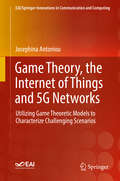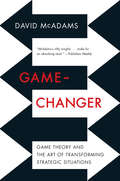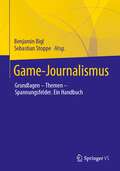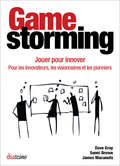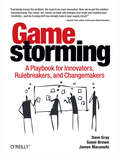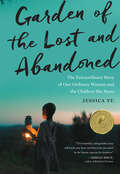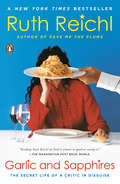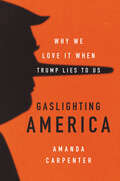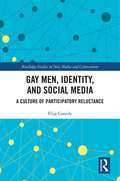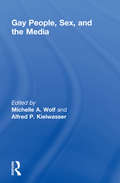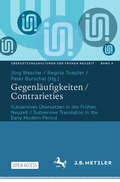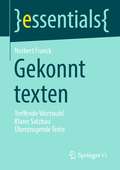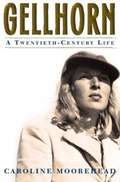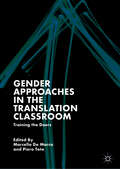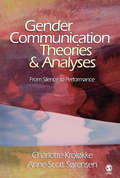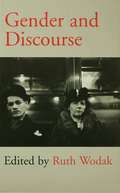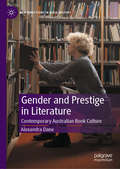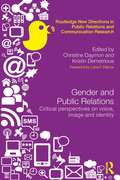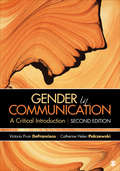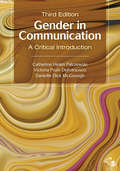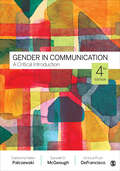- Table View
- List View
Game Theory in Wireless and Communication Networks
by Tamer Başar Zhu Han Dusit Niyato Walid Saad Are HjørungnesThis unified treatment of game theory focuses on finding state-of-the-art solutions to issues surrounding the next generation of wireless and communications networks. Future networks will rely on autonomous and distributed architectures to improve the efficiency and flexibility of mobile applications, and game theory provides the ideal framework for designing efficient and robust distributed algorithms. This book enables readers to develop a solid understanding of game theory, its applications and its use as an effective tool for addressing wireless communication and networking problems. The key results and tools of game theory are covered, as are various real-world technologies including 3G networks, wireless LANs, sensor networks, dynamic spectrum access and cognitive networks. The book also covers a wide range of techniques for modeling, designing and analysing communication networks using game theory, as well as state-of-the-art distributed design techniques. This is an ideal resource for communications engineers, researchers, and graduate and undergraduate students.
Game Theory, the Internet of Things and 5G Networks: Utilizing Game Theoretic Models to Characterize Challenging Scenarios (EAI/Springer Innovations in Communication and Computing)
by Josephina AntoniouThis book shows how to model selected communication scenarios using game theory. The book helps researchers specifically dealing with scenarios motivated by the increasing use of the Internet of Things (IoT) and 5G Communications by using game theory to approach the study of such challenging scenarios. The author explains how game theory acts as a mathematical tool that models decision making in terms of strategies and mechanisms that can result in optimal payoffs for a number of interacting entities, offering often antagonistic behaviors. The book explores new technologies in terms of design, development and management from a theoretical perspective, using game theory to analyze strategic situations and demonstrate profitable behaviors of the cooperative entities. The book identifies and explores several significant applications/uses/situations that arise from the vast deployment of the IoT. The presentation of the technological scenarios is followed in each of the first four chapters by a step-by-step theoretical model often followed by equilibrium proof, and numerical simulation results, that are explained in a tutorial-like manner. The four chapters tackle challenging IoT and 5G related issues, including: new security threats that IoT brings, e.g. botnets, ad hoc vehicular networks and the need for trust in vehicular communications, content repetition by offloading traffic onto mobile users, as well as issues due to new wearable devices that enable data collection to become more intrusive.
Game-Changer: Game Theory and the Art of Transforming Strategic Situations
by David McadamsA radically new, and easily learned, way to outstrategize your rivals. "The wise win before they fight, while the ignorant fight to win." So wrote Zhuge Liang, the great Chinese military strategist. He was referring to battlefield tactics, but the same can be said about any strategic situation. Even seemingly certain defeat can be turned into victory--whether in battle, business, or life--by those with the strategic vision to recognize how to "change the game" to their own advantage. The aim of David McAdams's Game-Changer is nothing less than to empower you with this wisdom--not just to win in every strategic situation (or "game") you face but to change those games and the ecosystems in which they reside to transform your life and our lives together for the better. Game-Changer develops six basic ways to change games--commitment, regulation, cartelization, retaliation, trust, and relationships--enlivened by countless colorful characters and unforgettable examples from the worlds of business, medicine, finance, military history, crime, sports, and more. The book then digs into several real-world strategic challenges, such as how to keep prices low on the Internet, how to restore the public's lost trust in for-charity telemarketers, and even how to save mankind from looming and seemingly unstoppable drug-resistant disease. In each case, McAdams uses the game-theory approach developed in the book to identify the strategic crux of the problem and then leverages that "game-awareness" to brainstorm ways to change the game to solve or at least mitigate the underlying problem. So get ready for a fascinating journey. You'll emerge a deeper strategic thinker, poised to change and win all the games you play. In doing so, you can also make the world a better place. "Just one Game-Changer [is] enough to seed and transform an entire organization into a more productive, happier, and altogether better place," McAdams writes. Just imagine what we can do together.
Game-Journalismus: Grundlagen – Themen – Spannungsfelder. Ein Handbuch
by Benjamin Bigl Sebastian StoppeDas Handbuch „Game-Journalismus“ bespricht erstmalig im deutschsprachigen Raum ein wenig beachtetes journalistisches Berufsfeld. Es führt kompakt in die Grundlagen des Game-Journalismus sowie dessen Entwicklung und Ausdifferenzierung ein und bespricht Trends und Herausforderungen für Journalismus, Spielerinnen und Spieler. Der Band zeigt die Vielfalt des Berufsfelds in den unterschiedlichen Mediengattungen und -formen, denn Games haben nicht nur einen festen Platz in der Kultur-, Wissenschafts- und Technikberichterstattung. Games und Phänomene der Computerspielekultur werden zunehmend auch in Online-Magazinen, professionellen und privaten Blogs, Podcasts und Video-Kanälen behandelt. Laien machen als Game-Influencer den etablierten Berufsfeldern Konkurrenz. Ausführlich werden Spannungsfelder reflektiert, mit denen Game-Journalisten konfrontiert werden und in denen sie agieren. Zudem werden aktuelle Befunde, Anforderungen des Jugendschutzes und des Urheberrechts, Monetarisierungsstrategien, die Veränderungen der Medienlandschaft sowie neue Vermittler und deren kreative Nutzerprodukte dargestellt und Vorschläge für die Aus- und Weiterbildung vom Game-Journalisten unterbreitet. Das Buch bietet sowohl wissenschaftliche als auch praktische Perspektiven auf eine vielfältige Publikationslandschaft und ist als ein Beitrag zur Erforschung des Game-Journalismus konzipiert.
Gamestorming - Jouer pour innover: A Playbook For Innovators, Rulebreakers, And Changemakers (O'reilly Ser.)
by James Macanufo Sunni Brown Dave GrayCe livre propose plus de 80 jeux avec des explications précises, accompagnés de dessins et croquis qui vous permettront de trouver des solutions en équipe à des problématiques auxquelles vous n’auriez peut-être jamais pensé.
Gamestorming: A Playbook for Innovators, Rulebreakers, and Changemakers (O'reilly Ser.)
by James Macanufo Sunni Brown Dave GrayGreat things don't happen in a vacuum. But creating an environment for creative thinking and innovation can be a daunting challenge. How can you make it happen at your company? The answer may surprise you: gamestorming.This book includes more than 80 games to help you break down barriers, communicate better, and generate new ideas, insights, and strategies. The authors have identified tools and techniques from some of the world's most innovative professionals, whose teams collaborate and make great things happen. This book is the result: a unique collection of games that encourage engagement and creativity while bringing more structure and clarity to the workplace. Find out why -- and how -- with Gamestorming.Overcome conflict and increase engagement with team-oriented gamesImprove collaboration and communication in cross-disciplinary teams with visual-thinking techniquesImprove understanding by role-playing customer and user experiencesGenerate better ideas and more of them, faster than ever beforeShorten meetings and make them more productiveSimulate and explore complex systems, interactions, and dynamicsIdentify a problem's root cause, and find the paths that point toward a solution
Gandhi's Printing Press
by Isabel HofmeyrAt the same time that Gandhi, as a young lawyer in South Africa, began fashioning the tenets of his political philosophy, he was absorbed by a seemingly unrelated enterprise: creating a newspaper. Gandhiâe(tm)s Printing Press is an account of how this project, an apparent footnote to a titanic career, shaped the man who would become the world-changing Mahatma. Pioneering publisher, experimental editor, ethical anthologistâe"these roles reveal a Gandhi developing the qualities and talents that would later define him. Isabel Hofmeyr presents a detailed study of Gandhiâe(tm)s work in South Africa (1893âe"1914), when he was the some-time proprietor of a printing press and launched the periodical Indian Opinion. The skills Gandhi honed as a newspapermanâe"distilling stories from numerous sources, circumventing shortages of typeâe"influenced his spare prose style. Operating out of the colonized Indian Ocean world, Gandhi saw firsthand how a global empire depended on the rapid transmission of information over vast distances. He sensed that communication in an industrialized age was becoming calibrated to technological tempos. But he responded by slowing the pace, experimenting with modes of reading and writing focused on bodily, not mechanical, rhythms. Favoring the use of hand-operated presses, he produced a newspaper to contemplate rather than scan, one more likely to excerpt Thoreau than feature easily glossed headlines. Gandhiâe(tm)s Printing Press illuminates how the concentration and self-discipline inculcated by slow reading, imbuing the self with knowledge and ethical values, evolved into satyagraha, truth-force, the cornerstone of Gandhiâe(tm)s revolutionary idea of nonviolent resistance.
Garden of the Lost and Abandoned: The Extraordinary Story of One Ordinary Woman and the Children She Saves
by Jessica YuThe problem by most lights is overwhelming: at least 5,000 children live on the streets of Uganda&’s capital city of Kampala. Some forget the names of their villages. The youngest may not know the names of their parents. But Gladys Kalibbala—part journalist, part detective, part Good Samaritan—does not hesitate to dive into difficult or even dangerous situations to aid a child. Author of a newspaper column called &“Lost and Abandoned,&” she is a resource that police and others turn to when they stumble across a stranded kid with a hidden history. Jessica Yu delivers an acutely observed story of this hardnosed and warmhearted woman, the children she helps, and the twists of fate they experience together. The subplot of Gladys&’s garden—her precarious dream of providing a home and livelihood for her vulnerable charges—adds fascinating depth. Garden of the Lost and Abandoned chronicles one woman&’s altruism, both ordinary and extraordinary, in a way that is impossible to forget, and impossible not to take to heart.
Garlic and Sapphires: The Secret Life of a Critic in Disguise
by Ruth ReichlGARLIC AND SAPPHIRES is Ruth Reichl's riotous account of the many disguises she employs to dine anonymously. There is her stint as Molly Hollis, a frumpy blond with manicured nails and an off-beige Armani suit that Ruth takes on when reviewing Le Cirque. The result: her famous double review of the restaurant: first she ate there as Molly; and then as she was coddled and pampered on her visit there as Ruth, New York Times food critic.What is even more remarkable about Reichl's spy games is that as she takes on these various disguises, she finds herself changed not just superficially, but in character as well. She gives a remarkable account of how one's outer appearance can very much influence one's inner character, expectations, and appetites.As she writes, "Every restaurant is a theater . . . even the modest restaurants offer the opportunity to become someone else, at least for a little while." GARLIC AND SAPPHIRES is a reflection on personal identity and role playing in the decadent, epicurean theaters of the restaurant world.
Gaslighting America: Why We Love It When Trump Lies to Us
by Amanda CarpenterAn examination of how Donald Trump’s lies and fabrications enthrall us and how we can avoid falling for them.Far too many people believe President Trump’s next outburst will be the one that finally brings him down. In fact, the exact opposite is true: his outrageous antics and wild lies are his biggest strength.This may drive you crazy. CNN contributor, ex-Ted Cruz staffer, and “Never Trump” adherent Amanda Carpenter says that’s the point. Over the years, Trump has developed a winning formula that forces anyone who stands in his way into a discombobulated state of weakness and confusion.In Gaslighting America, Carpenter breaks down Trump’s playbook, showing why it’s practically foolproof, manipulating all the major players—the Republicans, the Democrats, the media, and the victims of his method—perfectly. She traces how this tactic started with Nixon, gained traction with Bill Clinton, and exploded under Trump. Carpenter explains that when Trump seizes control over the political narrative, he always follows the same steps. First, he stakes out political territory no one else would dare occupy, taking over the news cycle. Next, he denies responsibility while simultaneously advancing the story. His third step may be his most maddening: he creates suspense for his story by saying more information is coming soon. His fourth step is carefully selecting a detractor to attack, often finding the weakest opponent or someone who will be severely damaged by taking a roll in the mud with him. If he’s successful, and sometimes even when he’s not, he’ll proceed to the fifth step: declaring victory under any circumstance.As a former communications staffer to Ted Cruz, Amanda Carpenter witnessed how her fellow Republicans fell in line behind Trump. As a political commentator, she was publicly smeared by one of his supporters on live television without a shred of evidence supporting the allegations. Slowly, she watched her entire party succumb to Trump and become defenders of his tactics. In this lively and thorough book, Carpenter skillfully gives Republicans and Democrats the information the need to counter President Trump’s most valuable weapon.
Gay Men, Identity and Social Media: A Culture of Participatory Reluctance (Routledge Studies in New Media and Cyberculture)
by Elija CassidyThis book explores how the social and technical integration of mainstream social media into gay men’s digital cultures since the mid 2000s has played out in the lives of young gay men, looking at how these convergences have influenced more recent iterations of gay men’s digital culture. Focusing on platforms such as Gaydar, Facebook, Grindr and Instagram, Cassidy highlights the ways that identity and privacy management issues experienced in this context have helped to generate a culture of participatory reluctance within gay men’s digital environments.
Gay People, Sex, and the Media
by Michelle Wolf Alfred KielwasserHere is a provocative book that examines precisely how and why mass communication has an impact upon the sexual realities of our lives. Written in response to a demand for information that cuts across many of the boundaries found in more traditional books on sexuality and mass communication, Gay People, Sex, and the Media covers a broad range of sexual identity, socialization, and mass communication issues and represents a variety of theoretical and methodological orientations. Although the chapters are diverse, they all focus on how the mass media--television, radio, films, newspapers, magazines, and recorded music--contribute significantly to the very definitions we form of ourselves and of each other. In part, this informative volume discusses and analyzes several concerns regarding minority perspectives in the context of the the study of mass media content and effects; analyzes mediated information about AIDS and highlights the responsibility of the mass media to disseminate more accurate information; addresses the relationships between mass media content (primarily television) and sexual socialization; explores issues confronted by individuals whose sexual orientations are generally perceived as falling out of the mainstream; and provides a selective bibliography of print, aural, and visual resources on gay men, lesbians, and the mass media. Unique in contrast to other books of research on human sexuality and mass communication, Gay People, Sex, and the Media gives more than a passing reference to issues concerning sexual identity and gay and lesbian concerns. Scholars and students of human sexuality, especially those who wish to explore their field from a communications perspective, will find this to be a valuable book. It is also useful to communications researchers and teachers, particularly those studying mediated communications in society, media ethics, and sex and the media. Finally, for professionals involved in creating or monitoring media content or forging public policy and community action programs in response to these issues, this volume serves as an essential sourcebook.
Gegenläufigkeiten / Contrarieties: Subversives Übersetzen in der Frühen Neuzeit / Subversive Translation in the Early Modern Period (Übersetzungskulturen der Frühen Neuzeit #4)
by Regina Toepfer Peter Burschel Jörg WescheTranslation und Subversion: Wie hängt beides zusammen? Das ist die Leitfrage dieses Sammelbands, der methodische Orientierungen und historische Studien zur Frühen Neuzeit in unterschiedlichen geographischen Settings und interlingualen Konstellationen vom 16. bis zum 18. Jahrhundert bietet. Translationswissenschaft, Romanistik, Japanologie, Germanistik und Musikwissenschaft sind die Disziplinen, die der Band zusammenbringt, um die besonders für frühneuzeitliche Übersetzungskulturen wenig gesehenen Gegenläufigkeiten in den Blick zu nehmen und auf subversive Übersetzung als Katalysator interkultureller Widerständigkeit, aber auch Unterwanderung scharfzustellen. Translation and subversion: how are the two related? That is the question pursued by this compilation of methodological orientations and historical studies on the Early Modern period in various geographical settings and interlingual constellations from the sixteenth to the eighteenth centuries. Bringing together a broad range of disciplines – translation studies, Romance studies, Japanology, German studies, and musicology – the volume takes a closer look at contrarieties hitherto little noticed, especially with regard to Early Modern translation cultures. In the process it focuses on subversive translation as a catalyst for intercultural resistivity as well as subversive action. Dies ist ein Open Access-Buch / This is an open access book.
Gekonnt texten: Treffende Wortwahl Klarer Satzbau Überzeugende Texte (essentials)
by Norbert FranckSchreiben heißt sich zeigen. Dieses essential zeigt, wie man sich schreibend von seiner besten Seite zeigt. Dieses essential vermittelt kompakt und anschaulich das Know-how und Handwerkszeug fürs Schreiben lesefreundlicher Texte, die Kunden überzeugen, Kolleginnen erfreuen, Vorgesetzte beeindrucken und Spenderinnen binden. Dieses essential ist keine Stilkunde mit erhobenem Zeigefinger, sondern erläutert praxisorientiert, wie man Schreibhürden überwindet und sich das Schreibleben erleichtert – wie man Freude am Schreiben entwickelt.
Gellhorn: A Twentieth-Century Life
by Caroline MooreheadMartha Gellhorn's heroic career as a reporter brought her to the front lines of virtually every significant international conflict between the Spanish Civil War and the end of the Cold War.
Gender Approaches in the Translation Classroom: Training the Doers
by Marcella De Marco Piero TotoThis volume examines strategies for embedding gender awareness within translation studies and translator training programmes. Drawing on a rich collection of theoretically-informed case studies, its authors provide practical advice and examples on implementing gender-inclusive approaches and language strategies in the classroom. It focuses on topics including, how to develop gender-inclusive practices to challenge students’ attitudes and behaviours; whether there are institutional constraints that prevent trainers from implementing non-heteronormative practices in their teaching; and how gender awareness can become an everyday mode of expression. Positioned at the lively interface of gender and translation studies, this work will be of interest to practitioners and scholars from across the fields of linguistics, education, sociology and cultural studies.
Gender Communication Theories and Analyses: From Silence to Performance
by Dr Charlotte Kroløkke Anne Scott SorensenGender Communication Theories and Analyses: From Silence to Performance surveys the field of gender and communication with a particular focus on feminist communication theories and methods - from structuralism to poststructuralism. In this text, authors Charlotte Krolokke and Ann Scott Sorensen help readers develop analytic focus and knowledge about their underlying assumptions that gender communication scholars use in their work.
Gender and Discourse
by Ruth WodakThe contributors to this collection offer an essential introduction to the ways in which feminist linguistics and critical discourse analysis have contributed to our understanding of gender and sex. By examining how these perspectives have been applied to these concepts, the contributors provide both a review of the literature, as well as an opportunity to follow the most recent debates in this area. Gender and Discourse brings together European, American and Australian traditions of research. Through an analysis of a range of `real' data, the contributors demonstrate the relevance of these theoretical and methodological insights for gender research in particular and social practice in general.
Gender and Prestige in Literature: Contemporary Australian Book Culture (New Directions in Book History)
by Alexandra DaneGender and Prestige in Literature: Contemporary Australian Book Culture explores the relationship between gender, power, reputation and book publishing’s consecratory institutions in the Australian literary field from 1965-2015. Focusing on book reviews, literary festivals and literary prizes, this work analyses the ways in which these institutions exist in an increasingly cooperative and generative relationship in the contemporary publishing industry, a system designed to limit field transformation. Taking an intersectional approach, this research acknowledges that a number of factors in addition to gender may influence the reception of an author or a title in the literary field and finds that progress towards equality is unstable and non-linear. By combining quantitative data analysis with interviews from authors, editors, critics, publishers and prize judges Alexandra Dane maps the circulation of prestige in Australian publishing, addressing questions around gender, identity, literary reputation, literary worth and the resilience of the status quo that have long plagued the field.
Gender and Public Relations: Critical Perspectives on Voice, Image and Identity (Routledge New Directions in PR & Communication Research)
by Christine Daymon Kristin DemetriousAlthough there is a small body of feminist scholarship that problematizes gender in public relations, gender is a relatively undefined area of thinking in the field and there have been few serious studies of the socially constructed roles defining women and men in public relations. This book is positioned within the critical public relations stream. Through the prism of ‘gender and public relations’, it examines not only the manipulatory, but also the emancipatory, subversive and transformatory potential of public relations for the construction of meaning. Its focus is on the dynamic interrelationships arising from public relations activities in society and the gendered, lived experiences of people working in the occupation of public relations. There are many previously unexplored areas within and through public relations which the book examines. These include: the production of social meaning and power relations advocacy and activist campaigns for social and political change the negotiation of identity, diversity and cultural practice celebrity, bodies, fashion and harassment in the workplace notions of managing reputation and communicating policy. In extending the field of inquiry, this edited collection highlights how gender is accomplished and transformed, and, thus how power is exercised and inequality (re)produced or challenged in public relations. The book will expand thinking about power relations and privilege for both women and men and how these are affected by the interplay of social, cultural and institutional practices. Winner of the Outstanding Book PRide Award, awarded by the National Communication Association (NCA).
Gender in Communication: A Critical Introduction
by Victoria Pruin Defrancisco Catherine H. Palczewski Danielle McgeoughGender in Communication: A Critical Introduction, Second Edition examines the variety of ways in which communication of and about gender enables and constrains people’s identities. Authors Catherine Helen Palczewski and Victoria Pruin DeFrancisco, with Danielle Dick McGeough, demonstrate how communication constitutes gender, rather than presenting gender as an influence on communication. Operating from an intersectional gender diversity perspective, they show how a focus on gender/sex alone omits the richness of diverse gendered lives. In addition, they explore how gender is constructed through interpersonal and public discourse in, about, and by the social institutions of family, education, work, religion, and media. Throughout the book, readers are equipped with critical analysis tools they can use to form their own conclusions about the ever-changing processes of gender in communication.
Gender in Communication: A Critical Introduction
by Catherine H. Palczewski Victoria Pruin DeFrancisco Danielle McGeoughGender in Communication: A Critical Introduction embraces the full range of diverse gender identities and expressions to explore how gender influences communication, as well as how communication shapes our concepts of gender for the individual and for society. This comprehensive gender communication book is the first to extensively address the roles of religion, the gendered body, single-sex education, an institutional analysis of gender construction, social construction theory, and more. Throughout the book, you are equipped with critical analysis tools you can use to form your own conclusions about the ever-changing processes of gender in communication. New to the Third Edition: Current examples in the chapter openers illustrate how a critical gendered lens is necessary and useful by discussing recent events, such as Jon Stewart’s critique of the outcry over a J. Crew ad, reactions to Serena Williams’s body, photos of a young boy who likes to wear dresses, and the use of Photoshop to create thigh gaps. Updated chapters on voices, work, education, and family reflect major shifts in the state of knowledge. Expanded sections on trans and gender non-conforming identities reflect changes in language. All other chapters have been updated with new examples, new concepts, and new research. More than 500 new sources have been integrated throughout, and new sections on debates over bathroom bills, intensive mothering, humor, swearing, and Title IX have been added. “His” and “her” pronouns have been replaced with “they” in most cases, even if the reference is singular, in an effort to be more inclusive.
Gender in Communication: A Critical Introduction
by Catherine H. Palczewski Victoria Pruin DeFrancisco Danielle McGeoughGender in Communication: A Critical Introduction embraces the full range of diverse gender identities and expressions to explore how gender influences communication, as well as how communication shapes our concepts of gender for the individual and for society. This comprehensive gender communication book is the first to extensively address the roles of religion, the gendered body, single-sex education, an institutional analysis of gender construction, social construction theory, and more. Throughout the book, you are equipped with critical analysis tools you can use to form your own conclusions about the ever-changing processes of gender in communication. New to the Third Edition: Current examples in the chapter openers illustrate how a critical gendered lens is necessary and useful by discussing recent events, such as Jon Stewart’s critique of the outcry over a J. Crew ad, reactions to Serena Williams’s body, photos of a young boy who likes to wear dresses, and the use of Photoshop to create thigh gaps. Updated chapters on voices, work, education, and family reflect major shifts in the state of knowledge. Expanded sections on trans and gender non-conforming identities reflect changes in language. All other chapters have been updated with new examples, new concepts, and new research. More than 500 new sources have been integrated throughout, and new sections on debates over bathroom bills, intensive mothering, humor, swearing, and Title IX have been added. “His” and “her” pronouns have been replaced with “they” in most cases, even if the reference is singular, in an effort to be more inclusive.
Gender in Communication: A Critical Introduction
by Catherine H. Palczewski Victoria Pruin DeFrancisco Danielle McGeoughGender in Communication: A Critical Introduction embraces the full range of diverse gender identities and expressions to explore how gender influences communication, as well as how communication shapes our concepts of gender for the individual and for society at large. Authors Catherine Helen Palczewski, Danielle D. McGeough, and Victoria Pruin DeFrancisco equip readers with the critical analysis tools to form their own conclusions about the ever changing processes of gender in communication. This comprehensive gender communication book is the first to extensively address the roles of religion, the gendered body, single-sex education, an institutional analysis of gender construction, social construction theory, and more. The Fourth Edition has streamlined the text to make it more accessible to students without sacrificing the sophistication of the book′s trademark intersectional approach.
Gender in Communication: A Critical Introduction
by Catherine H. Palczewski Victoria Pruin DeFrancisco Danielle McGeoughGender in Communication: A Critical Introduction embraces the full range of diverse gender identities and expressions to explore how gender influences communication, as well as how communication shapes our concepts of gender for the individual and for society at large. Authors Catherine Helen Palczewski, Danielle D. McGeough, and Victoria Pruin DeFrancisco equip readers with the critical analysis tools to form their own conclusions about the ever changing processes of gender in communication. This comprehensive gender communication book is the first to extensively address the roles of religion, the gendered body, single-sex education, an institutional analysis of gender construction, social construction theory, and more. The Fourth Edition has streamlined the text to make it more accessible to students without sacrificing the sophistication of the book′s trademark intersectional approach.

